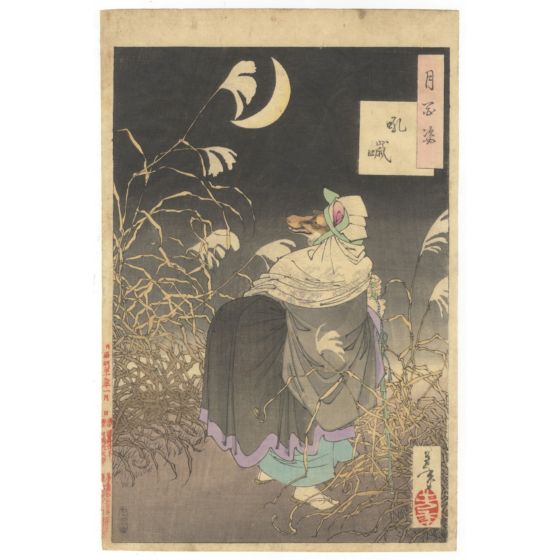Yoshitoshi Tsukioka, Cry of the Fox, One Hundred Aspects of the Moon
Artist: Yoshitoshi Tsukioka (1839-1892)
Title: The Cry of the Fox (Konkai)
Series title: One Hundred Aspects of the Moon
Publisher: Akiyama Buemon
Date: 1885-1892
Size: 35.8 x 23.9 cm
Condition: Slightly trimmed, wear and soiling, tear on the left.
'One Hundred Aspects of the Moon' is one of Yoshitoshi's most popular series. It contains one hundred woodblock prints depicting various, unrelated figures from Japanese and Chinese culture, with the moon as its unifying theme and exploring a range of tones and emotions for the subjects depicted. Yoshitoshi worked within a traditional art form, yet his drawings incorporated western techniques and were unlike any style that had come before him. The series was begun in 1885 and completed just before the artist's death in 1892.
Traditionally, foxes are regarded as deceitful creatures in Japan as they possess the ability to take the form of human beings. This picture deals with Konkai (The Cry of the Fox), a play from the Kyogen drama. The story is about a hunter who is visited by his uncle, a priest by the name of Hakuzosu. After the hunter and Hakuzosu speak about the cruelty of killing foxes, the hunter realises that the man he had just had a conversation with was not his uncle but a fox in disguise. This fox later turns back into its original form and ironically gets caught in a trap.
Yoshitoshi captures the moment where the priest turns back into a fox. He still stands on his two feet, and his hand are that of a human, but he has already grown a fox's tail - marked by the abnormal bulge on his back - and his head has changed into that of a fox. The picture is mostly monochrome, but the intricate design of the snarled leaves and the engraving on the priest's headdress make this an intriguing work to observe.
Yoshitoshi Tsukioka
Yoshitoshi Tsukioka was one of the leading woodblock print artists during the Meiji era (1868-1912) and one of the last to work in the traditional ukiyo-e manner. Born in Edo (today’s Tokyo), he showed a strong interest in classical Japanese literature and history. When he was 11, he became a student at Kuniyoshi Utagawa’s studio. Under his teacher’s guidance, he showed exquisite draftsmanship and learned how to draw from life, something not necessarily part of the training schools of painting and illustration in Japan.
Yoshitoshi’s rise as an artist came at a time when Japan was faced with great changes and challenges. The new Meiji era (1868-1912) brought many conflicts between those loyal to tradition and those wishing to embark on a process of forced modernisation and adoption of western values. These sentiments, along with having witnessed some of the violent uprisings, influenced his early career, with intense, often disturbing images that reflect turmoil and pain. Even so, many other prints from this early period show whimsical touches, with reinterpretation of themes seen in his teacher Kuniyoshi’s works. With deep cultural roots, Yoshitoshi’s style was dynamic and distinctive: he was known for experimentation in style and genre, as well as for his innovative works. He worked on series depicting kabuki actors, bijinga (pictures of beautiful women), warriors, monsters and ghosts. Supernatural themes abound in his later work, showing a fascination for old Japanese folk stories.
The publishing of Yoshitoshi’s most popular series 'One Hundred Aspects of the Moon' commenced in 1885 and spanned a wide variety of subjects, such as warrior, animals, ghosts, natural phenomena, beauties and others. The artist’s early tendency for gore and horror was replaced by images of lyricism, calm, spirituality and psychological depth. 'Thirty-two Aspects of Customs and Manners', published in 1888, shows Yoshitoshi’s ability to portray emotions like no other artist of his time, presenting women of various background and eras in Japanese history, each with distinct traits.
In 1889, the series 'New Forms of Thirty-six Ghosts' started to be published, showing images of apparitions, mostly based on folklore and plays, depicted powerfully and imaginatively. This was, perhaps, a catharsis for the artist who claimed to have seen ghosts and strongly believed in supernatural beings. Many of Yoshitoshi’s late works were acclaimed at a time when western techniques of mass production such as photography were making the woodblock obsolete, breaking new ground by portraying intense human feelings through a traditional medium. He became a master teacher and had notable pupils such as Toshikata Mizuno and Toshihide Migita.
| Print Format | Oban (Vertical) |
|---|---|
| Artist | Yoshitoshi Tsukioka |
| Subject | Ghosts & Religion, Animal & Birds |
| Dimensions | 35.8 x 23.9 cm |
| Condition Report | Slightly trimmed, wear and soiling, tear on the left. |
| Series | One Hundred Aspects of the Moon |







